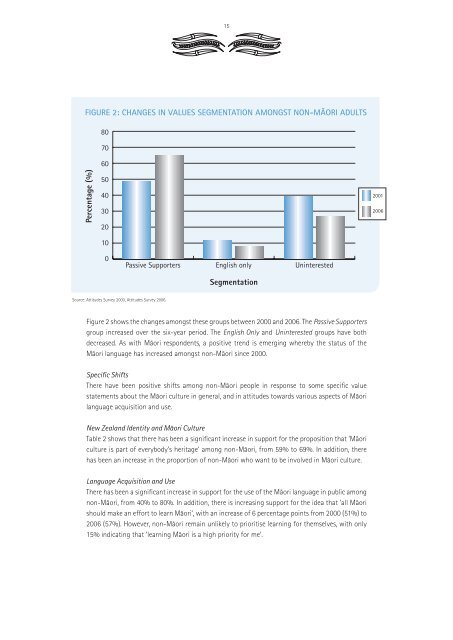The Health of the Maori Language in 2006 - Te Puni Kokiri
The Health of the Maori Language in 2006 - Te Puni Kokiri
The Health of the Maori Language in 2006 - Te Puni Kokiri
Create successful ePaper yourself
Turn your PDF publications into a flip-book with our unique Google optimized e-Paper software.
15<br />
FIGURE 2: CHANGES IN VALUES SEGMENTATION AMONGST NON-MÄORI ADULTS<br />
80<br />
70<br />
60<br />
Percentage (%)<br />
50<br />
40<br />
30<br />
20<br />
2001<br />
<strong>2006</strong><br />
10<br />
0<br />
Passive Supporters English only Un<strong>in</strong>terested<br />
Segmentation<br />
Source: Attitudes Survey 2000, Attitudes Survey <strong>2006</strong>.<br />
Figure 2 shows <strong>the</strong> changes amongst <strong>the</strong>se groups between 2000 and <strong>2006</strong>. <strong>The</strong> Passive Supporters<br />
group <strong>in</strong>creased over <strong>the</strong> six-year period. <strong>The</strong> English Only and Un<strong>in</strong>terested groups have both<br />
decreased. As with Mäori respondents, a positive trend is emerg<strong>in</strong>g whereby <strong>the</strong> status <strong>of</strong> <strong>the</strong><br />
Mäori language has <strong>in</strong>creased amongst non-Mäori s<strong>in</strong>ce 2000.<br />
Specific Shifts<br />
<strong>The</strong>re have been positive shifts among non-Mäori people <strong>in</strong> response to some specific value<br />
statements about <strong>the</strong> Mäori culture <strong>in</strong> general, and <strong>in</strong> attitudes towards various aspects <strong>of</strong> Mäori<br />
language acquisition and use.<br />
New Zealand Identity and Mäori Culture<br />
Table 2 shows that <strong>the</strong>re has been a significant <strong>in</strong>crease <strong>in</strong> support for <strong>the</strong> proposition that ‘Mäori<br />
culture is part <strong>of</strong> everybody’s heritage’ among non-Mäori, from 59% to 69%. In addition, <strong>the</strong>re<br />
has been an <strong>in</strong>crease <strong>in</strong> <strong>the</strong> proportion <strong>of</strong> non-Mäori who want to be <strong>in</strong>volved <strong>in</strong> Mäori culture.<br />
<strong>Language</strong> Acquisition and Use<br />
<strong>The</strong>re has been a significant <strong>in</strong>crease <strong>in</strong> support for <strong>the</strong> use <strong>of</strong> <strong>the</strong> Mäori language <strong>in</strong> public among<br />
non-Mäori, from 40% to 80%. In addition, <strong>the</strong>re is <strong>in</strong>creas<strong>in</strong>g support for <strong>the</strong> idea that ‘all Mäori<br />
should make an effort to learn Mäori’, with an <strong>in</strong>crease <strong>of</strong> 6 percentage po<strong>in</strong>ts from 2000 (51%) to<br />
<strong>2006</strong> (57%). However, non-Mäori rema<strong>in</strong> unlikely to prioritise learn<strong>in</strong>g for <strong>the</strong>mselves, with only<br />
15% <strong>in</strong>dicat<strong>in</strong>g that ‘learn<strong>in</strong>g Mäori is a high priority for me’.

















